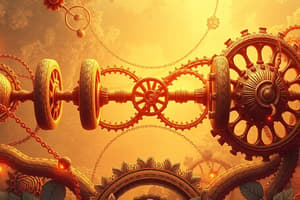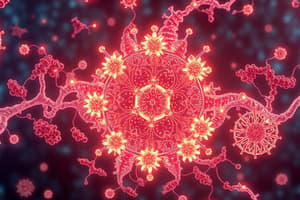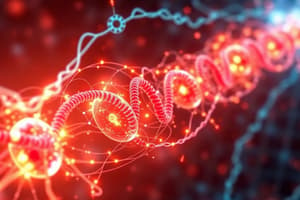Podcast
Questions and Answers
During the electron transport chain (ETC), what is the primary role of oxygen?
During the electron transport chain (ETC), what is the primary role of oxygen?
- To directly generate ATP through substrate-level phosphorylation.
- To act as the final electron acceptor, forming water. (correct)
- To transport protons across the inner mitochondrial membrane, creating a gradient.
- To oxidize NADH and FADH2, releasing carbon dioxide.
Why does NADH contribute to the production of more ATP than FADH2 within the electron transport chain?
Why does NADH contribute to the production of more ATP than FADH2 within the electron transport chain?
- NADH enters the ETC at an earlier complex, pumping more protons. (correct)
- FADH2 directly donates electrons to oxygen, bypassing proton pumping.
- NADH carries more electrons than FADH2.
- FADH2 is more readily available in the cytoplasm, reducing transport costs.
Approximately what percentage of the energy derived from the oxidation of glucose is conserved in the chemical bonds of ATP?
Approximately what percentage of the energy derived from the oxidation of glucose is conserved in the chemical bonds of ATP?
- 90-100%
- 60-70%
- 30-40% (correct)
- 10-20%
How does the electron transport chain (ETC) drive the endergonic reaction of ATP synthase?
How does the electron transport chain (ETC) drive the endergonic reaction of ATP synthase?
If the complete aerobic oxidation of one molecule of glucose yields approximately 32 ATP, how many ATP are generated from 1 NADH + H+?
If the complete aerobic oxidation of one molecule of glucose yields approximately 32 ATP, how many ATP are generated from 1 NADH + H+?
In the context of cellular respiration, what is the primary function of the numerous enzymes located within the mitochondria?
In the context of cellular respiration, what is the primary function of the numerous enzymes located within the mitochondria?
Which of the following statements accurately describes the flow of electrons through the electron transport chain?
Which of the following statements accurately describes the flow of electrons through the electron transport chain?
How many ATP molecules are generated from FADH2?
How many ATP molecules are generated from FADH2?
Flashcards
Redox Reactions
Redox Reactions
Biochemical reactions involving oxidation and reduction that produce energy.
Mitochondria
Mitochondria
Cellular organelle where the electron transport chain occurs.
Electron Transport Chain (ETC)
Electron Transport Chain (ETC)
A series of protein complexes that transfer electrons from NADH and FADH2 to oxygen, creating ATP.
Oxidative Phosphorylation
Oxidative Phosphorylation
Signup and view all the flashcards
NADH
NADH
Signup and view all the flashcards
FADH2
FADH2
Signup and view all the flashcards
Oxygen's Role in ETC
Oxygen's Role in ETC
Signup and view all the flashcards
Aerobic Oxidation
Aerobic Oxidation
Signup and view all the flashcards
Study Notes
- Oxidation and reduction reactions drive energy metabolism.
- Mitochondria extract electrons from hydrogen and transfer them to oxygen.
- ATP synthesis results from redox reactions.
- Mitochondria possess up to 10 billion enzymes.
- Electron transport forms the respiratory chain.
- ATP is synthesized by transferring electrons from NADH and FADH2 to oxygen.
- NADH and FADH2 are oxidized, and oxygen is reduced.
- NADH + H+ yields 2.5 ATP
- FADH2 yields 1.5 ATP
- Actual ATP generation is 3 from NADH and 2 from FADH2
- Some energy shuttles across the mitochondrial membrane is spent.
- Only 30-40% of energy is conserved in ATP's chemical bonds.
- The rest is lost as heat, in accordance with the Second Law of Thermodynamics.
- The electron transport chain (ETC) is a vital part of cellular respiration.
- Cellular respiration occurs in two phases within the mitochondria; Phase 1 is the citric acid cycle, and Phase 2 is the electron transport chain
- Oxidative phosphorylation, paired with the electron transport system, generate; 2.5 ATP per NADH + H+
- 2 ATP during substrate-level phosphorylation
- Overall, oxidative phosphorylation nets 32 ATP
Key questions about the ETC
- How is ATP produced?
- What drives ATP synthase's endergonic reaction?
- Why does NADH yield more ATP than FADH2?
- What is oxygen's purpose in the ETC?
Calculations for complete aerobic oxidation:
- Ability to determine ATP, NADH, and FADH2 production from: glucose, G6P from glycogen, lactate.
Studying That Suits You
Use AI to generate personalized quizzes and flashcards to suit your learning preferences.
Related Documents
Description
Oxidation-reduction reactions drive energy metabolism. ATP synthesis results from redox reactions where electrons are extracted and transferred to oxygen via the electron transport chain. This process involves the oxidation of NADH and FADH2, with oxygen being reduced, ultimately generating ATP, though some energy is lost as heat.




